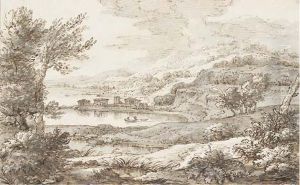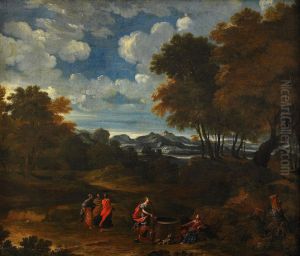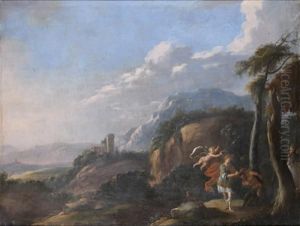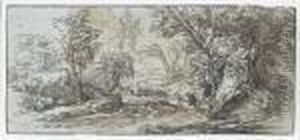Abraham I Genoels Paintings
Abraham I Genoels, also known as Abraham Genoels II or Abraham Genouil, was a Flemish Baroque painter and engraver who was active during the 17th and early 18th centuries. Born on February 17, 1640, in Antwerp, Belgium, he became known for his landscape paintings and architectural designs. Though not as widely recognized as some of his contemporaries, Genoels' work reflects the rich artistic traditions of the Flemish Baroque period, exhibiting the influence of both the northern European and Italianate styles.
Genoels received his initial training in Antwerp under the direction of artists like Nicolaes Fierlants and Joris van Son. Seeking to advance his skills and make a name for himself, Genoels left Antwerp for Paris in 1659. In Paris, he worked under the tutelage of the landscape painter François Millet. During his time in France, Genoels became a member of the Guild of Saint Luke, an association of artists. His stay in France was fruitful, and he established a reputation as a skilled painter, particularly of landscapes.
In 1665, Genoels left Paris for Rome, which was then the center of the art world. The city's classical ruins, Renaissance masterpieces, and vibrant artistic community profoundly influenced him. He was admitted to the Bentvueghels, a society of mainly Dutch and Flemish artists working in Rome, and was given the nickname 'Archimedes' because of his interest in geometry and architectural drawing. During his time in Rome, he was patronized by important figures such as Cardinal Leopoldo de' Medici and worked on various projects, including the decoration of the Gallery of Alexander VII in the Vatican.
After spending about 14 years in Rome, Genoels returned to Antwerp in 1679, where he became a master in the Guild of Saint Luke. He shared his Italian experiences by incorporating the grandeur and classical elements he had absorbed into his works. His landscapes were characterized by a precise drawing style, clarity, and serene elegance, often including classical ruins and mythological references. Genoels also worked as an architect and an art dealer, contributing to the diffusion of Italianate taste in the Low Countries.
Genoels' career continued to prosper in his native country, where he received commissions from various patrons, including religious institutions and members of the nobility. His works were collected by art connoisseurs and fellow artists, influencing the next generation of landscape painters.
Abraham Genoels died on April 19, 1723, in Antwerp. Although he is less known today, his engravings and drawings are still appreciated by art historians and collectors for their technique and the way they embody the cross-cultural artistic exchanges of the Baroque era. His works can be found in various museums and art collections throughout Europe.



